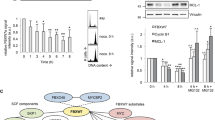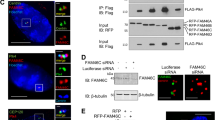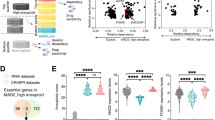Abstract
Fbw7 is a tumor suppressor that is mutated in numerous cancers. It encodes an E3 ubiquitin ligase, whose ability to decrease the levels of pivotal regulators of cell growth and proliferation underlies its tumor suppressor function. Here, we explore the consequences of Fbw7 inactivation on the outcome of chemotherapeutic treatments. When exposed to spindle toxins such as vinblastine and taxol, Fbw7-deficient cells undergo extensive mitotic slippage and endoreduplication, rendering them polyploid. A combined deregulation of several Fbw7 target proteins is required for this phenotype. Specifically, elevated expression of cyclin E and Aurora A in Fbw7-deficient cells is required for drug-induced polyploidy. However, overexpression of either cyclin E or Aurora A alone is not sufficient for drug-induced polyploidy. In addition, we demonstrate that Fbw7 deficiency limits the ability of p53 to respond to mitotic toxins but not to DNA damage. Furthermore, Fbw7 expression regulates the p53-dependent induction of genes such as Lats2 and p21 in response to vinblastine. Hence, we suggest that Fbw7 serves as a master regulator of the mitotic and tetraploidy checkpoints.
This is a preview of subscription content, access via your institution
Access options
Subscribe to this journal
Receive 50 print issues and online access
$259.00 per year
only $5.18 per issue
Buy this article
- Purchase on Springer Link
- Instant access to full article PDF
Prices may be subject to local taxes which are calculated during checkout







Similar content being viewed by others
References
Anand S, Penrhyn-Lowe S, Venkitaraman AR . (2003). AURORA-A amplification overrides the mitotic spindle assembly checkpoint, inducing resistance to Taxol. Cancer Cell 3: 51–62.
Aylon Y, Michael D, Shmueli A, Yabuta N, Nojima H, Oren M . (2006). A positive feedback loop between the p53 and Lats2 tumor suppressors prevents tetraploidization. Genes Dev 20: 2687–2700.
Bartkova J, Horejsi Z, Koed K, Kramer A, Tort F, Zieger K et al. (2005). DNA damage response as a candidate anti-cancer barrier in early human tumorigenesis. Nature 434: 864–870.
Brito DA, Rieder CL . (2006). Mitotic checkpoint slippage in humans occurs via cyclin B destruction in the presence of an active checkpoint. Curr Biol 16: 1194–1200.
Cassia R, Moreno-Bueno G, Rodriguez-Perales S, Hardisson D, Cigudosa JC, Palacios J . (2003). Cyclin E gene (CCNE) amplification and hCDC4 mutations in endometrial carcinoma. J Pathol 201: 589–595.
Chen SS, Chang PC, Cheng YW, Tang FM, Lin YS . (2002). Suppression of the STK15 oncogenic activity requires a transactivation-independent p53 function. EMBO J 21: 4491–4499.
Deffie A, Hao M, Montes de Oca Luna R, Hulboy DL, Lozano G . (1995). Cyclin E restores p53 activity in contact-inhibited cells. Mol Cell Biol 15: 3926–3933.
Di Leonardo A, Khan SH, Linke SP, Greco V, Seidita G, Wahl GM . (1997). DNA rereplication in the presence of mitotic spindle inhibitors in human and mouse fibroblasts lacking either p53 or pRb function. Cancer Res 57: 1013–1019.
Doxsey S, Zimmerman W, Mikule K . (2005). Centrosome control of the cell cycle. Trends Cell Biol 15: 303–311.
Ekholm-Reed S, Spruck CH, Sangfelt O, van Drogen F, Mueller-Holzner E, Widschwendter M et al. (2004). Mutation of hCDC4 leads to cell cycle deregulation of cyclin E in cancer. Cancer Res 64: 795–800.
Fujii Y, Yada M, Nishiyama M, Kamura T, Takahashi H, Tsunematsu R et al. (2006). Fbxw7 contributes to tumor suppression by targeting multiple proteins for ubiquitin-dependent degradation. Cancer Sci 97: 729–736.
Gritsko TM, Coppola D, Paciga JE, Yang L, Sun M, Shelley SA et al. (2003). Activation and overexpression of centrosome kinase BTAK/Aurora-A in human ovarian cancer. Clin Cancer Res 9: 1420–1426.
Gupta-Rossi N, Le Bail O, Gonen H, Brou C, Logeat F, Six E et al. (2001). Functional interaction between SEL-10, an F-box protein, and the nuclear form of activated Notch1 receptor. J Biol Chem 276: 34371–34378.
Hubalek MM, Widschwendter A, Erdel M, Gschwendtner A, Fiegl HM, Muller HM et al. (2004). Cyclin E dysregulation and chromosomal instability in endometrial cancer. Oncogene 23: 4187–4192.
Katayama H, Sasai K, Kawai H, Yuan ZM, Bondaruk J, Suzuki F et al. (2004). Phosphorylation by aurora kinase A induces Mdm2-mediated destabilization and inhibition of p53. Nat Genet 36: 55–62.
Kimura T, Gotoh M, Nakamura Y, Arakawa H . (2003). hCDC4b, a regulator of cyclin E, as a direct transcriptional target of p53. Cancer Sci 94: 431–436.
Koepp DM, Schaefer LK, Ye X, Keyomarsi K, Chu C, Harper JW et al. (2001). Phosphorylation-dependent ubiquitination of cyclin E by the SCFFbw7 ubiquitin ligase. Science 294: 173–177.
Kwak EL, Moberg KH, Wahrer DC, Quinn JE, Gilmore PM, Graham CA et al. (2005). Infrequent mutations of Archipelago (hAGO, hCDC4, Fbw7) in primary ovarian cancer. Gynecol Oncol 98: 124–128.
Libertini SJ, Robinson BS, Dhillon NK, Glick D, George M, Dandekar S et al. (2005). Cyclin E both regulates and is regulated by calpain 2, a protease associated with metastatic breast cancer phenotype. Cancer Res 65: 10700–10708.
Liu Q, Kaneko S, Yang L, Feldman RI, Nicosia SV, Chen J et al. (2004). Aurora-A abrogation of p53 DNA binding and transactivation activity by phosphorylation of serine 215. J Biol Chem 279: 52175–52182.
Mao JH, Perez-Losada J, Wu D, Delrosario R, Tsunematsu R, Nakayama KI et al. (2004). Fbxw7/Cdc4 is a p53-dependent, haploinsufficient tumour suppressor gene. Nature 432: 775–779.
Marumoto T, Zhang D, Saya H . (2005). Aurora-A—a guardian of poles. Nat Rev Cancer 5: 42–50.
Meraldi P, Honda R, Nigg EA . (2002). Aurora-A overexpression reveals tetraploidization as a major route to centrosome amplification in p53−/− cells. EMBO J 21: 483–492.
Minella AC, Clurman BE . (2005). Mechanisms of tumor suppression by the SCF(Fbw7). Cell Cycle 4: 1356–1359.
Minella AC, Grim JE, Welcker M, Clurman BE . (2007). p53 and SCF(Fbw7) cooperatively restrain cyclin E-associated genome instability. Oncogene 26: 6948–6953.
Minella AC, Swanger J, Bryant E, Welcker M, Hwang H, Clurman BE . (2002). p53 and p21 form an inducible barrier that protects cells against cyclin E-cdk2 deregulation. Curr Biol 12: 1817–1827.
Minella AC, Welcker M, Clurman BE . (2005). Ras activity regulates cyclin E degradation by the Fbw7 pathway. Proc Natl Acad Sci USA 102: 9649–9654.
Moberg KH, Bell DW, Wahrer DC, Haber DA, Hariharan IK . (2001). Archipelago regulates cyclin E levels in Drosophila and is mutated in human cancer cell lines. Nature 413: 311–316.
Moberg KH, Mukherjee A, Veraksa A, Artavanis-Tsakonas S, Hariharan IK . (2004). The Drosophila F box protein archipelago regulates dMyc protein levels in vivo. Curr Biol 14: 965–974.
Montagnoli A, Fiore F, Eytan E, Carrano AC, Draetta GF, Hershko A et al. (1999). Ubiquitination of p27 is regulated by Cdk-dependent phosphorylation and trimeric complex formation. Genes Dev 13: 1181–1189.
Nakayama K, Nagahama H, Minamishima YA, Miyake S, Ishida N, Hatakeyama S et al. (2004). Skp2-mediated degradation of p27 regulates progression into mitosis. Dev Cell 6: 661–672.
Nateri AS, Riera-Sans L, Da Costa C, Behrens A . (2004). The ubiquitin ligase SCFFbw7 antagonizes apoptotic JNK signaling. Science 303: 1374–1378.
Oberg C, Li J, Pauley A, Wolf E, Gurney M, Lendahl U . (2001). The Notch intracellular domain is ubiquitinated and negatively regulated by the mammalian Sel-10 homolog. J Biol Chem 276: 35847–35853.
Parisi T, Beck AR, Rougier N, McNeil T, Lucian L, Werb Z et al. (2003). Cyclins E1 and E2 are required for endoreplication in placental trophoblast giant cells. EMBO J 22: 4794–4803.
Rajagopalan H, Jallepalli PV, Rago C, Velculescu VE, Kinzler KW, Vogelstein B et al. (2004). Inactivation of hCDC4 can cause chromosomal instability. Nature 428: 77–81.
Sheaff RJ, Groudine M, Gordon M, Roberts JM, Clurman BE . (1997). Cyclin E-CDK2 is a regulator of p27Kip1. Genes Dev 11: 1464–1478.
Spruck CH, Strohmaier H, Sangfelt O, Muller HM, Hubalek M, Muller-Holzner E et al. (2002). hCDC4 gene mutations in endometrial cancer. Cancer Res 62: 4535–4539.
Spruck CH, Won KA, Reed SI . (1999). Deregulated cyclin E induces chromosome instability. Nature 401: 297–300.
Stewart ZA, Leach SD, Pietenpol JA . (1999). p21(Waf1/Cip1) inhibition of cyclin E/Cdk2 activity prevents endoreduplication after mitotic spindle disruption. Mol Cell Biol 19: 205–215.
Strohmaier H, Spruck CH, Kaiser P, Won KA, Sangfelt O, Reed SI . (2001). Human F-box protein hCdc4 targets cyclin E for proteolysis and is mutated in a breast cancer cell line. Nature 413: 316–322.
Takahashi T, Futamura M, Yoshimi N, Sano J, Katada M, Takagi Y et al. (2000). Centrosomal kinases, HsAIRK1 and HsAIRK3, are overexpressed in primary colorectal cancers. Jpn J Cancer Res 91: 1007–1014.
Tanaka T, Kimura M, Matsunaga K, Fukada D, Mori H, Okano Y . (1999). Centrosomal kinase AIK1 is overexpressed in invasive ductal carcinoma of the breast. Cancer Res 59: 2041–2044.
Toji S, Yabuta N, Hosomi T, Nishihara S, Kobayashi T, Suzuki S et al. (2004). The centrosomal protein Lats2 is a phosphorylation target of Aurora-A kinase. Genes Cells 9: 383–397.
Vlach J, Hennecke S, Amati B . (1997). Phosphorylation-dependent degradation of the cyclin-dependent kinase inhibitor p27. EMBO J 16: 5334–5344.
Waldman T, Lengauer C, Kinzler KW, Vogelstein B . (1996). Uncoupling of S phase and mitosis induced by anticancer agents in cells lacking p21 (see comments). Nature 381: 713–716.
Wei W, Jin J, Schlisio S, Harper JW, Kaelin Jr WG . (2005). The v-Jun point mutation allows c-Jun to escape GSK3-dependent recognition and destruction by the Fbw7 ubiquitin ligase. Cancer Cell 8: 25–33.
Welcker M, Clurman BE . (2005). The SV40 large T antigen contains a decoy phosphodegron that mediates its interactions with Fbw7/hCdc4. J Biol Chem 280: 7654–7658.
Welcker M, Orian A, Jin J, Grim JA, Harper JW, Eisenman RN et al. (2004). The Fbw7 tumor suppressor regulates glycogen synthase kinase 3 phosphorylation-dependent c-Myc protein degradation. Proc Natl Acad Sci USA 101: 9085–9090.
Wu G, Lyapina S, Das I, Li J, Gurney M, Pauley A et al. (2001). SEL-10 is an inhibitor of notch signaling that targets notch for ubiquitin-mediated protein degradation. Mol Cell Biol 21: 7403–7415.
Yada M, Hatakeyama S, Kamura T, Nishiyama M, Tsunematsu R, Imaki H et al. (2004). Phosphorylation-dependent degradation of c-Myc is mediated by the F-box protein Fbw7. EMBO J 23: 2116–2125.
Acknowledgements
We thank B Vogelstein, K Nakayama, B Clurman and M Madryj for providing us with valuable reagents. This work was supported by grant number 492/05 from the Israeli Science Foundation and grant number 3702 from the Nadia Shaskin Foundation, Public Committee for Allocation of Estate Funds, Ministry of Justice and the Ministry of Health, Israel (to ES) and grant R37 CA40099 from the National Cancer Institute and EC FP6 grant LSHC-CT-2004-503576 (to MO).
Author information
Authors and Affiliations
Corresponding author
Additional information
Supplementary Information accompanies the paper on the Oncogene website (http://www.nature.com/onc).
Rights and permissions
About this article
Cite this article
Finkin, S., Aylon, Y., Anzi, S. et al. Fbw7 regulates the activity of endoreduplication mediators and the p53 pathway to prevent drug-induced polyploidy. Oncogene 27, 4411–4421 (2008). https://doi.org/10.1038/onc.2008.77
Received:
Revised:
Accepted:
Published:
Issue Date:
DOI: https://doi.org/10.1038/onc.2008.77
Keywords
This article is cited by
-
FBXW7 in breast cancer: mechanism of action and therapeutic potential
Journal of Experimental & Clinical Cancer Research (2023)
-
FBXO45-MYCBP2 regulates mitotic cell fate by targeting FBXW7 for degradation
Cell Death & Differentiation (2020)
-
MicroRNA-32 promotes cell proliferation, migration and suppresses apoptosis in breast cancer cells by targeting FBXW7
Cancer Cell International (2017)
-
FBXW7 negatively regulates ENO1 expression and function in colorectal cancer
Laboratory Investigation (2015)
-
Emerging roles of the FBW7 tumour suppressor in stem cell differentiation
EMBO reports (2012)



